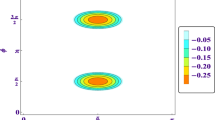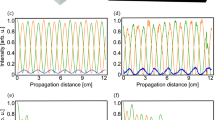Abstract
Quantum information processing is largely dependent on the robustness of non-classical correlations, such as entanglement and quantum discord. However, all the realistic quantum systems are thermodynamically open and lose their coherence with time through environmental interaction. The time evolution of quantum entanglement, discord, and the respective classical correlation for a single, spin-1/2 particle under spin and energy degrees of freedom, with an initial Werner state, has been investigated in the present study. The present intra-particle system is considered to be easier to produce than its inter-particle counterpart. Experimentally, this type of system may be realized in the well-known Penning trap. The most stable correlation was identified through maximization of a system-specific global objective function. Quantum discord was found to be the most stable, followed by the classical correlation. Moreover, all the correlations were observed to attain highest robustness under initial Bell state, with minimum possible dephasing and decoherence parameters.



Similar content being viewed by others
References
Nielsen, M.A., Chuang, I.L.: Quantum Computation and Quantum Information. Cambridge University Press, Cambridge (2000)
Modi, K., Brodutch, A., Cable, H., Paterek, T., Vedral, V.: The classical-quantum boundary for correlations: discord and related measures. Rev. Mod. Phys. 84, 1655–1707 (2012)
Deutsch, D.: Quantum theory, the Church–Turing principle and the universal quantum computer. Proc. R. Soc. Lond. A 400, 97–117 (1985)
Shor P.W.: Polynomial-time algorithms for prime factorization and discrete logarithms on a quantum computer. In: Proceedings in 35th Annual Symposium on the Foundations of Computer Science, pp. 124–134. IEEE Computer Society Press (1994)
Bennet C.H., Brassard G.: Quantum cryptography: public key distribution and coin tossing. In: Proceedings in IEEE International Conference on Computers, Syste, and Signal Processing Bangalore, India, pp. 175–179 (1984)
Bennett, C.H., et al.: Teleporting an unknown quantum state via dual classical and Einstein–Podolsky–Rosen channels. Phys. Rev. Lett. 70, 1895–1899 (1993)
Bennett, C.H., DiVincenzo, D.P.: Quantum information and computation. Nature 404, 247–255 (2000)
Ollivier, H., Zurek, W.H.: Quantum discord: a measure of the quantumness of correlations. Phys. Rev. Lett. 88, 017901 (2001)
Henderson, L., Vedral, V.: Classical, quantum and total correlations. J. Phys. A 34, 6899–6905 (2001)
Celeri, L.C., Maziero, J., Serra, R.M.: Theoretical and experimental aspects of quantum discord and related measures. Int. J. Quantum Inf. 09, 1837 (2011)
Ali, M.: Quantum dissonance provide power to deterministic quantum computation with single qubit. arXiv:1312.1572 (2013)
Datta, A., Shaji, A., Caves, C.M.: Quantum discord and the power of one qubit. Phys. Rev. Lett. 100, 050502 (2008)
Knill, E., Laflamme, R.: Power of one bit of quantum information. Phys. Rev. Lett. 81, 5672 (1998)
Walborn, S.P.: Hyperentanglement: breaking the communication barrier. Nat. Phys. 4, 268–269 (2008)
Vallone, G., Pomarico, E., Mataloni, P., Martini, F.D., Berardi, V.: Realization and characterization of a two-photon four-qubit linear cluster state. Phys. Rev. Lett. 98, 180502 (2007)
Wang, C., Cao, C., He, L., Zhang, C.: Hybrid entanglement concentration using quantum dot and microcavity coupled system. Quantum Inf. Process. 13(4), 1025–1034 (2014)
Waks, E., Monroe, C.: Protocol for hybrid entanglement between a trapped atom and a quantum dot. Phys. Rev. A 80, 062330 (2009)
Neves, L., Lima, G., Delgado, A., Saavedra, C.: Hybrid photonic entanglement: realization, characterization, and applications. Phys. Rev. A 80, 042322 (2009)
Wei-Bo, Gao, et al.: Experimental realization of a controlled-NOT gate with four-photon six-qubit cluster states. Phys. Rev. Lett. 104(2), 020501 (2010)
O’Sullivan-Hale, M.N., Khan, I.A., Boyd, R.W., Howell, J.C.: Pixel entanglement: experimental realization of optically entangled d \(=\) 3 and d \(=\) 6 qudits. Phys. Rev. Lett. 94, 220501 (2005)
Ali-Khan, I., Broadbent, C.J., Howell, J.C.: Large-alphabet quantum key distribution using energy-time entangled bipartite states. Phys. Rev. Lett. 98, 060503 (2007)
Blasone, M., DellAnno, F., Siena, S.D., Illuminati, F.: Entanglement in neutrino oscillations. Europhys. Lett. 85, 50002 (2009)
Huang, P., Zhu, J., Qi, X., He, G., Zeng, G.: Different dynamics of classical and quantum correlations under decoherence. Quantum Inf. Process. 11, 1845–1865 (2012)
Wood, C.J., et al.: Quantum correlations in a noisy neutron interferometer. Phys. Rev. A 90(3), 032315 (2014)
Hasegawa, Y.: Entanglement between degrees of freedom in a single-particle system revealed in neutron interferometry. Found. Phys. 42(1), 29–45 (2010)
Hasegawa, Y., Loidl, R., Badurek, G., Durstberger-Rennhofer, K., Sponar, S., Rauch, H.: Engineering of triply entangled states in a single-neutron system. Phys. Rev. A 81(3), 032121 (2010)
Rodriguez-Rosario, C.A., Modi, K., Kuah, A., Shaji, A., Sudarshan, E.C.G.: Completely positive maps and classical correlations. J. Phys. A 41, 205301 (2008)
Brodutch, A., Datta, A., Modi, K., Rivas, A., Rodriguez-Rosario, C.A.: Vanishing quantum discord is not necessary for completely positive maps. Phys. Rev. A 87(4), 042301 (2013)
Fuwa M., Takeda S., Zwierz M., Wiseman H.M., Furusawa A.: Experimental proof of nonlocal wavefunction collapse for a single particle using homodyne measurements. Nat. Commun. 6 (2015) (Article number: 6665)
Hardesty L.: Toward practical quantum computers: technique extends duration of fragile quantum states. Phys.org (2015)
Du, C., Wang, H., Yang, F., Hammel, P.C.: Systematic variation of spin-orbit coupling with d-orbital filling: large inverse spin Hall effect in 3d transition metals. Phys. Rev. B 90(14), 140407 (2014)
Ricks, A.M., Brathwaite, A.D., Duncan, M.A.: Coordination and spin states in vanadium carbonyl complexes (V(CO)n+, n = 1–7) revealed with IR spectroscopy. J Phys. Chem. A 117(6), 1001–1010 (2013)
Willis, C.R., Bergmann, P.G.: Quantum mechanical Liouville equation for a system in contact with a reservoir. Phys. Rev. 128(1), 391 (1962)
Linbald, G.: On the generators of quantum dynamical semigroups. Commun. Math Phys. 48(2), 119–130 (1976)
Hill, S., Wootters, W.K.: Entanglement of a pair of quantum bits. Phys. Rev. Lett. 78, 5022 (1997)
Wootters, W.K.: Entanglement of formation of an arbitrary state of two qubits. Phys. Rev. Lett. 80, 2245 (1998)
Wootters, W.K.: Entanglement of formation and concurrence. Quantum Inf. Comput. 1(1), 27–44 (2001)
Luo, S.: Quantum discord for two-qubit systems. Phys. Rev. A 77, 042303 (2008)
Werner, R.F.: Quantum states with Einstein–Podolsky–Rosen correlations admitting a hidden-variable model. Phys. Rev. A 40(8), 4277 (1989)
Li, X.F., Fang, M.F., Wang, C.Z., Hou, L.Z.: Dissipative dynamics of quantum and classical correlations for two-qubit under two-side and one-side decoherence. J. At. Mol. Sci. 3(2), 177–186 (2012)
Yoo, H.I., Eberly, J.H.: Dynamical theory of an atom with two or three levels interacting with quantized cavity fields. Phys. Rep. 118, 239–337 (1985)
Eberly, J.H., Narzohny, N.B., Sanchez-Mondragon, J.J.: Periodic spontaneous collapse and revival in a simple quantum model. Phys. Rev. Lett. 44(20), 1323 (1980)
Gea-Banacloche, J.: Collapse and revival of the state vector in the Jaynes–Cummings model: an example of state preparation by a quantum apparatus. Phys. Rev. Lett. 65(27), 3385 (1990)
Berrada, K., Eleuch, H., Hassouni, Y.: Asymptotic dynamics of quantum discord in open quantum systems. J. Phys. B At. Mol. Opt. Phys. 44, 145503 (2011)
Montgomery, D.C.: Design and Analysis of Experiments. Wiley, New York (2004)
Fanchini, F.F., Castelano, L.K., Caldeira, A.O.: Entanglement versus quantum discord in two coupled double quantum dots. New J. Phys. 12, 073009 (2010)
Brown, L.S., Gabrielse, G.: Geonium theory: physics of a single electron or ion in a Penning trap. Rev. Mod. Phys. 58(1), 233 (1986)
Pedersen, L.H., Rangan, C.: Controllability and universal three-qubit quantum computation with trapped electron states. Quantum Inf. Process. 7(1), 33–42 (2008)
Lamata, L., Porras, D., Cirac, J.I.: Towards electron-electron entanglement in Penning traps. Phys. Rev. A 81, 022301 (2010)
Acknowledgments
This project work has been funded by University Grants Commission (UGC), India, under Grant No. F. PSW-108/12-13 (ERO). The contribution of UGC is gratefully acknowledged.
Author information
Authors and Affiliations
Corresponding author
Appendix: The quantum Liouville equation and its solution for a single spin-1/2 particle
Appendix: The quantum Liouville equation and its solution for a single spin-1/2 particle
Equation (26) was analytically solved in congruence with Eq. (2) as
The lower triangular elements of the density operator can be obtained from Hermitian property\(\left( {\rho _{ij} ^{*}=\rho _{ji} } \right) \).
Rights and permissions
About this article
Cite this article
Saha, P., Sarkar, D. Robustness measure of hybrid intra-particle entanglement, discord, and classical correlation with initial Werner state. Quantum Inf Process 15, 791–807 (2016). https://doi.org/10.1007/s11128-015-1210-y
Received:
Accepted:
Published:
Issue Date:
DOI: https://doi.org/10.1007/s11128-015-1210-y




